India’s rich craft traditions are a beautiful reflection of the nation’s deep-rooted culture and history. From the towering Himalayas in the North to the southernmost tip of Kanyakumari, each region Is unique, handmade treasures that are much more than just art. These crafts are lifelines for many communities, providing income and preserving their cultural identity.
In this article, we’ll see India’s diverse craft heritage, exploring the distinct styles from North to South. From the colorful block prints of Rajasthan to the delicate filigree work of Odisha, we’ll look at the stories behind these ancient traditions and see how artisans are blending tradition with modern innovation. Whether you’re an art lover, a thoughtful reader, or someone curious about India’s culture.
India is a country full of beautiful handmade things. craftspeople all over India create beautiful things using skills passed down through generations. From the snowy mountains in the north to the sunny beaches in the south, people make many different crafts. These regional crafts show India’s rich culture and help many people in earn a living.
In this article, we’ll learn about Indian crafts. Traditional crafts not only reflect regional identities but also connect communities to their historical roots. In this article we will see crafts from North India to South India, We’ll see the soft shawls made in Kashmir, the blue pottery from Rajasthan, the detailed embroidery from Uttar Pradesh, and the shiny silk clothes from Tamil Nadu. We’ll also look at many other crafts.
As we explore these regional crafts, we’ll see how they show the special things about each area. We’ll learn why they’re important for local communities and how they’re changing in today’s world. If you also want to know more about it, Come with us and we will see the beauty and importance of India’s many crafts!
The Cultural Significance of Traditional Indian Crafts
Crafts in India’s History and Economy
Traditional Indian craft have played a crucial role in the country’s history and economy for centuries. In the past, kings and queens would hire skilled craftsman to make beautiful things for their palaces. Today, these traditional crafts continue to be a significant source of livelihood, particularly in rural areas and small towns across India. The craft sector contributes substantially to the India’s economy, providing employment to millions along with preserving cultural heritage.
Crafts Showing Regional Identities
Each area in India has its own special crafts. These crafts tell us about the local culture and traditions. For example:
– In Rajasthan, people make colourful puppet dolls that are used in storytelling.
– In Kashmir, craftspeople weave soft, warm shawls that help in the cold weather.
– In Kerala, artists make detailed wooden carvings that show local stories and beliefs.
These different crafts help people feel proud of where they come from.
- How Globalization Affects Traditional Indian Craft
Positives
Due to globalization new opportunities have emerged worldwide for Indian crafts. Several e-commerce portals have allowed the artisans to display and sell their work directly to the consumers without having to depend on any distributors. This expansion in exposure has created a greater appreciation of Indian handicrafts across the globe which may lead to better opportunities economically for the skilled crafts people.
Challenges
In spite of these opportunities, traditional Indian craft are encountering greater challenges in the globalised society. In many cases, mass-produced, machine-made products are more affordable than hand-made items, therefore making it hard for the artists to be in the market. In addition, the younger generation’s changing lifestyle and employment choices have contributed to the diminishing population of crafts people and therefore endangering some craft heritage.
Traditional Indian craft represent more than just decorative or functional objects; they embody the living heritage of diverse communities across the country. As bearers of cultural identity and economic potential, these craft traditions continue to evolve, adapting to modern contexts while maintaining their roots in age-old skills and knowledge.
North Indian Crafts
Kashmir
- Pashmina shawls
Pashmina shawls, originating from Kashmir, have a rich history In 15th century, when they were worn by royalty and nobility for their exquisite softness and warmth.
These are super soft, warm shawls made from special goat wool. Also They’re very light but keep you really warm. People love them because they’re comfy and look fancy.
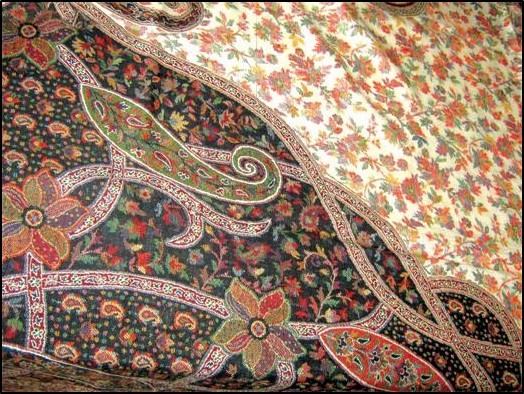
- Kashmiri carpets and rugs
Kashmiri carpets and rugs originated in the 15th century, when Persian artisans were brought to Kashmir to teach their craft.These are beautiful floor coverings with detailed designs. They’re made by hand, knotting colourful threads together. Many have nature patterns like flowers and trees.
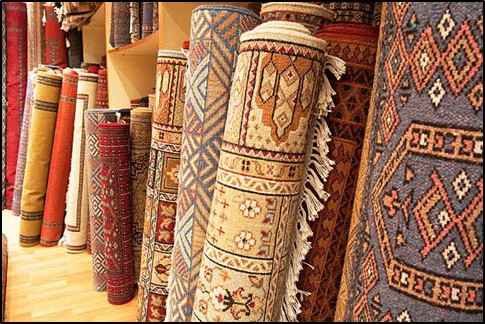
- Papier-mâché art: history
Papier-mâché art, a versatile and expressive craft, has a long history in ancient civilizations.This is made by sticking layers of paper together and painting them. Artists make decorative boxes, vases, and even furniture this way. They’re known for bright colours and shiny finishes.
Rajasthan
- Blue pottery of Jaipur
Blue Pottery of Jaipur is a traditional craft, originally from Persia, known for its beautiful blue designs, and was reintroduced in the 20th century.This isn’t regular pottery – it’s bright blue and white. It’s called “blue pottery” because of its colour. People use it to make plates, vases, and decorative items.
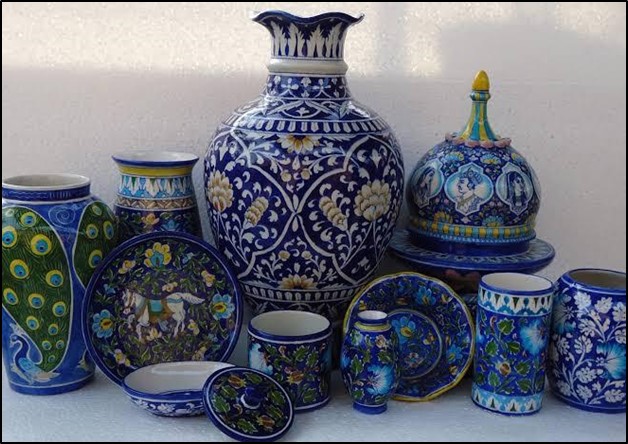
- Rajasthani miniature paintings
Rajasthani miniature paintings Originated in the 16th century in the royal courts of Rajasthan, blending indigenous styles with Persian and Mughal influences, Representing themes of mythology, court life, and nature in intricate detail. - These are tiny, detailed paintings, often on paper or silk. They usually show scenes from stories or everyday life. Artists use very fine brushes to make such small, precise pictures.correct the painting it is

- Bandhani tie-dye textiles
Bandhani tie-dye textiles, a traditional craft from Gujarat and Rajasthan, Originated in ancient India, characterized by intricate patterns created through resist dyeing, often used in vibrant garments for religious, cultural, and celebratory occasions.
This is a special way of dyeing cloth to make patterns. People tie tiny knots in the fabric before dyeing it. It creates dotted designs, often in bright colours.
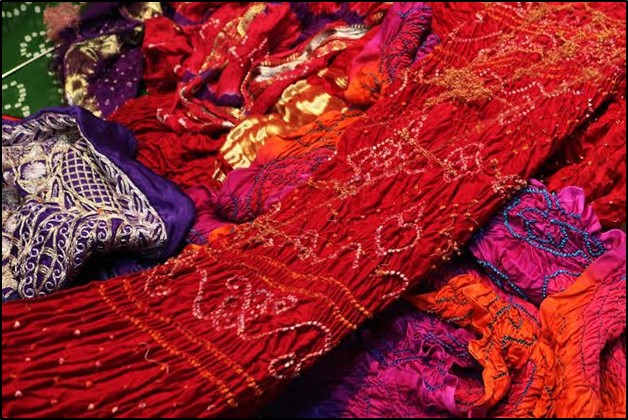
Uttar Pradesh
- Chikan embroidery of Lucknow
Chikan embroidery of Lucknow, believed to have been introduced during the Mughal era, is a delicate and intricate hand-embroidery technique using fine stitches on muslin, creating elegant floral and geometric patterns, traditionally associated with royal and aristocratic attire.
This is delicate needlework done on light fabrics. It creates patterns that look almost see-through. It’s often used on clothes like shirts and dresses.
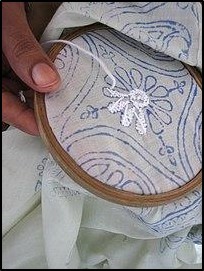
- Banarasi silk weaving
Banarasi silk weaving, originating in the ancient city of Varanasi, is renowned for its opulent silk sarees adorned with intricate gold and silver brocade, a tradition that flourished under Mughal patronage and remains a symbol of luxury and craftsmanship in Indian textiles.
This is a special type of silk cloth made in Varanasi (also called Banaras). It’s known for golden or silver designs woven into colourful silk. It’s often used to make fancy sarees (traditional Indian dresses).
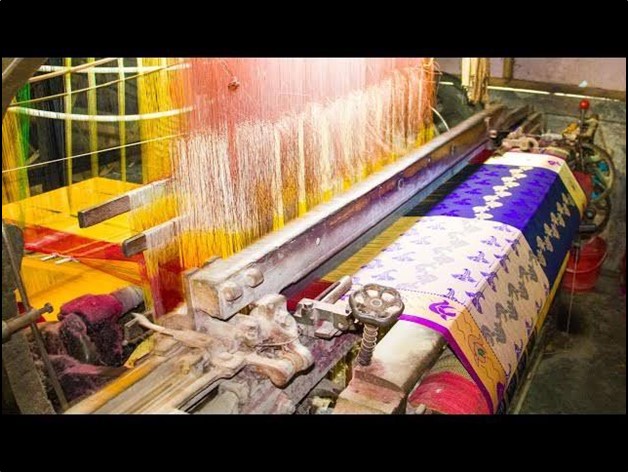
- Marble inlay work of Agra
Marble inlay work of Agra, perfected during the Mughal era, involves embedding semi-precious stones into marble to create intricate floral and geometric designs, with the Taj Mahal being the most iconic example of this exquisite craftsmanship.
This involves putting tiny pieces of coloured stone into marble. It creates beautiful patterns and pictures on things like tabletops or wall decorations. The Taj Mahal is famous for this kind of work.

North East Indian Crafts
Assam
- Muga silk weaving
Muga silk weaving has a rich history in Assam, India, over 2,000 years, where it is traditionally associated with the state’s cultural identity and royal patronage; it was highly valued in ancient times for its durability and unique golden color, often used for ceremonial and bridal attire, and is now recognized as a Geographical Indication (GI) product, symbolizing the region’s artisanal heritage.
Muga is a special golden-coloured silk made only in Assam. It’s very strong and shiny, and gets brighter with washing. People use it to make sarees and other clothes.
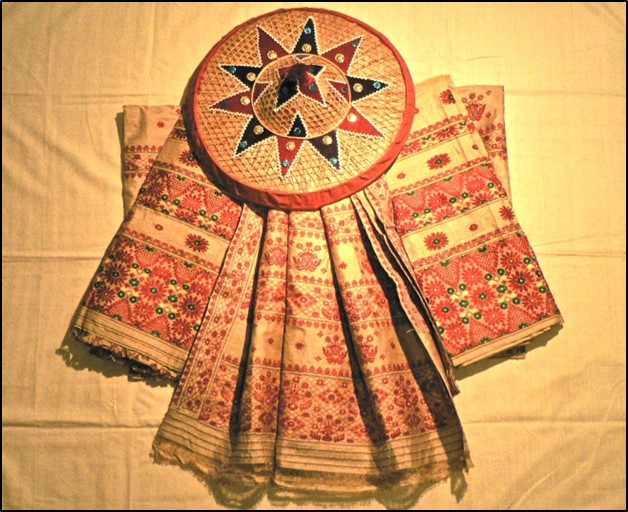
- Assamese masks
These are colourful face masks used in traditional dances and plays.They’re often made of bamboo and cloth, painted with bright colours. Each mask represents a different character or animal.
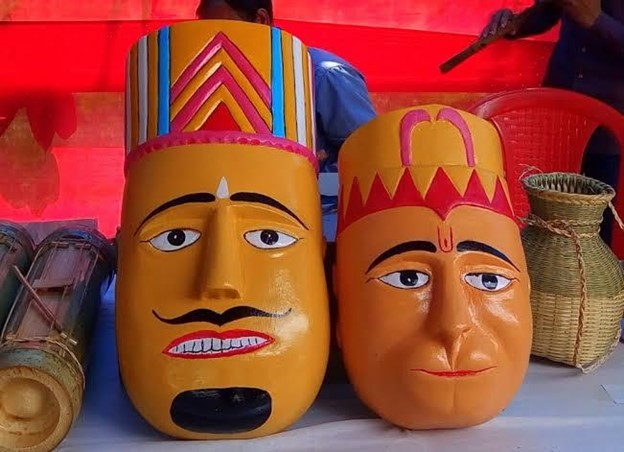
- Cane and bamboo crafts
People in Assam make many useful things from cane and bamboo. This includes baskets, furniture, and even musical instruments. These crafts are eco-friendly and very strong.
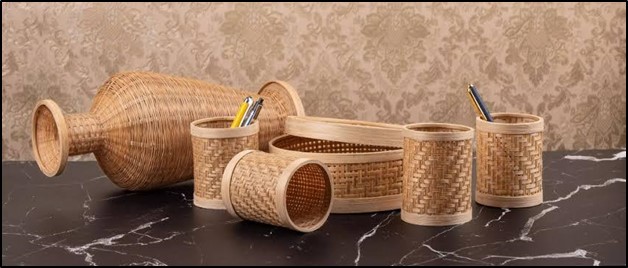
Nagaland
- Naga shawls and textiles
Naga shawls and textiles originating from the diverse tribes of Nagaland, India, where they have been woven for centuries to reflect tribal identity, social status, and cultural heritage; traditionally made from locally sourced fibers like wool and cotton, these textiles feature intricate patterns and vibrant colors that carry symbolic meanings, and they play a important role in ceremonies, rituals, and everyday life, embodying the artistic traditions and craftsmanship of the Naga people.
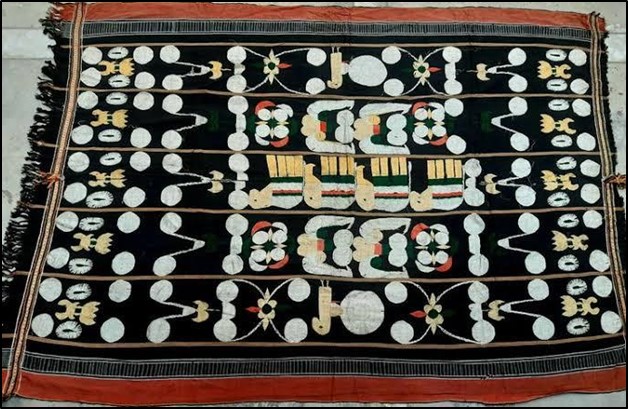
Each Naga tribe has its own special designs for shawls and clothes. These often have bold, colorful patterns. The designs can tell you about a person’s tribe and social status.
- Wood carving
Naga people are skilled at carving designs into wood. They make decorative items and useful things like bowls and tool handles.Many carvings show animals or tribal symbols.

- Metalwork and jewellery
Naga metalworkers make tools, weapons, and beautiful jewellery. They often use materials like brass and silver. Many pieces have traditional designs that are important to Naga culture.
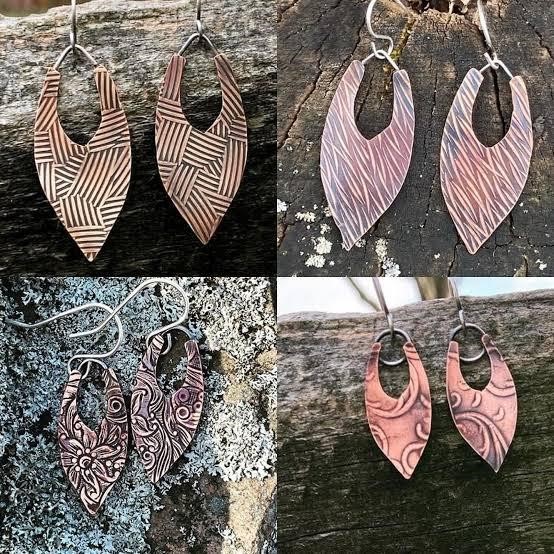
Manipur
- Kauna reed crafts
Kauna is a type of reed that grows in Manipur’s wetlands. People weave it to make mats, bags, and other items. These crafts are eco-friendly and becoming popular outside Manipur too.
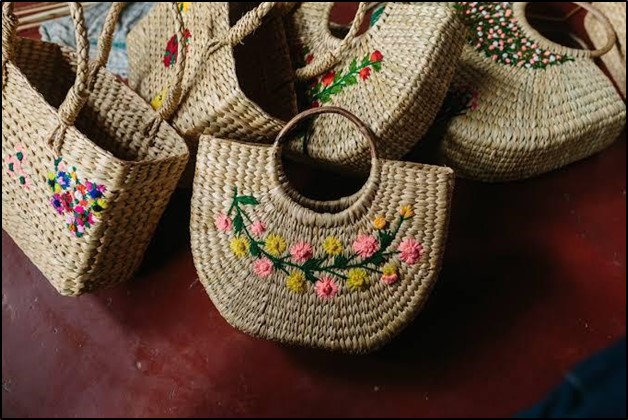
- Moirang Phee textiles
This is a type of cotton cloth with beautiful woven designs. It’s often used to make traditional Manipuri clothes. The patterns usually show nature scenes or geometric shapes.
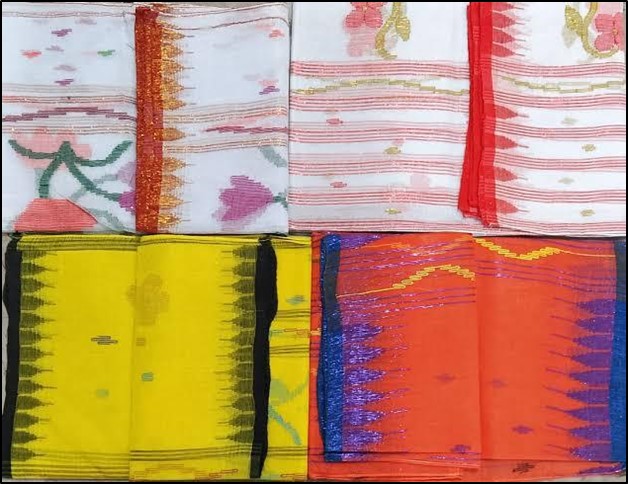
- Longpi pottery
Manipur Longpi pottery, also known as black stone pottery, is a traditional craft of the Tangkhul Naga tribe, originating from Longpi village in Manipur, India, and is known for its unique use of serpentine rock and clay, with roots tracing back centuries to indigenous practices.
This black pottery is made from a special type of clay and powdered rock. It’s shaped by hand, not on a potter’s wheel. The pots are known for being very strong and good for cooking.
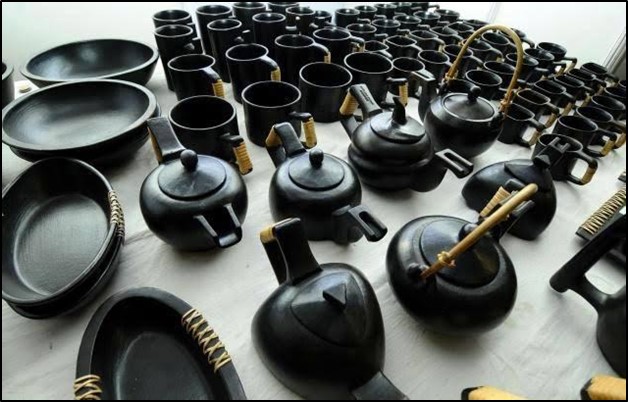
Arunachal Pradesh
- Monpa handmade paper
The Monpa handmade paper of Arunachal Pradesh is an ancient art form practiced by the Monpa tribe, over a thousand years, using the indigenous Shugu-Seng tree bark, and historically linked to Buddhist scriptures and manuscripts in the region.
This is paper made from the bark of a local tree. It’s very strong and lasts a long time. People use it for writing, painting, and making crafts.

- Tribal weaves and textiles
The tribal weaves and textiles of Arunachal Pradesh, known for their vibrant colors and intricate patterns, are centuries old tradition practiced by various indigenous tribes, each using unique techniques and motifs that representing their cultural heritage, with textiles like shawls, skirts, and jackets playing a vital role in their social and ritualistic life.
Each tribe in Arunachal Pradesh has its own style of weaving. They make colorful clothes, bags, and blankets. The designs often tell stories about the tribe’s history and beliefs.
- Bamboo and cane products
The bamboo and cane products of Arunachal Pradesh, are centuries old. They are integral to the region’s culture, with various tribes skillfully weaving these natural materials into baskets, mats, and furniture, reflecting their deep connection to the forested environment and sustainable living.
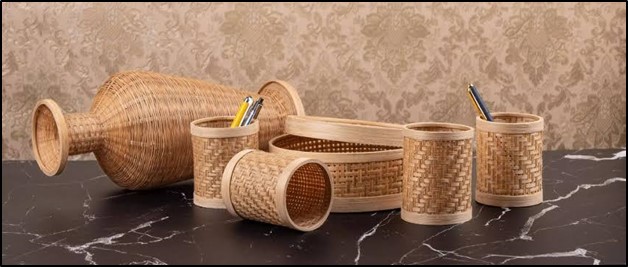
Like in Assam, people here are skilled at making things from bamboo and cane.They create baskets, hats, bags, and even bridges! These crafts are important for daily life in many villages.
Meghalaya
- Garo bamboo crafts
Garo bamboo crafts of Meghalaya are also known as centuries old for their deep connection to nature through the craft which they make. The Garo people are especially good at making things from bamboo. They create baskets, fish traps, musical instruments, and more. These crafts are both useful and beautiful.
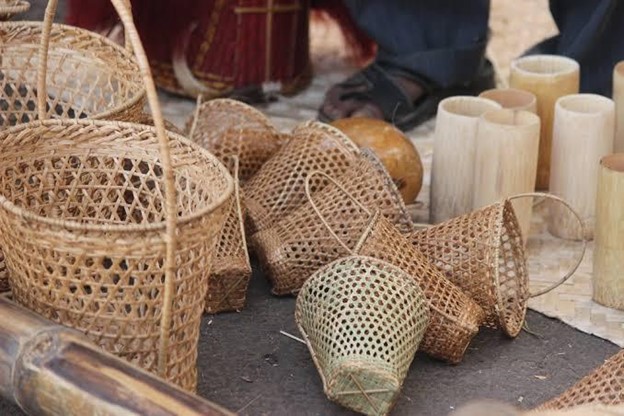
- Ryndia silk weaving
Ryndia is a type of silk made by eri silkworms. It’s very warm and is sometimes called “poor man’s silk”. People weave it into shawls and other clothes.
- Khasi jewellery
The Khasi people make unique jewellery, often using gold and coral. Many pieces have special meanings in Khasi culture. Traditional designs include earrings, necklaces, and crowns for special occasions.
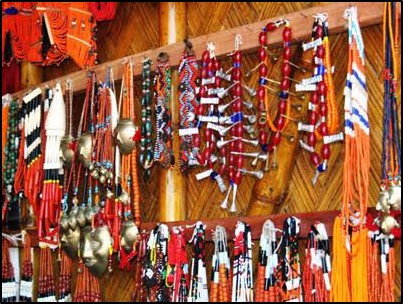
Central Indian Crafts
Madhya Pradesh
- Chanderi and Maheshwari handloom weaving
Chanderi and Maheshwari handloom weaving, originating in Madhya Pradesh, in the 2nd century, known for their lightweight fabrics, intricate motifs, and royal patronage, with Chanderi known for its silk-cotton blends and Maheshwari for its reversible borders and geometric patterns.
These are light, soft fabrics often used for sarees. Chanderi fabric can be silk or cotton, with shiny threads woven in. Maheshwari fabric is known for its bright colours and simple designs.

- Gond tribal art
Gond tribal art is centuries old art of the Gond community of central art. This is colorful artwork made by the Gond tribe. It often shows nature scenes with dots and lines. Artists use this style to paint on paper, walls, and even pottery.
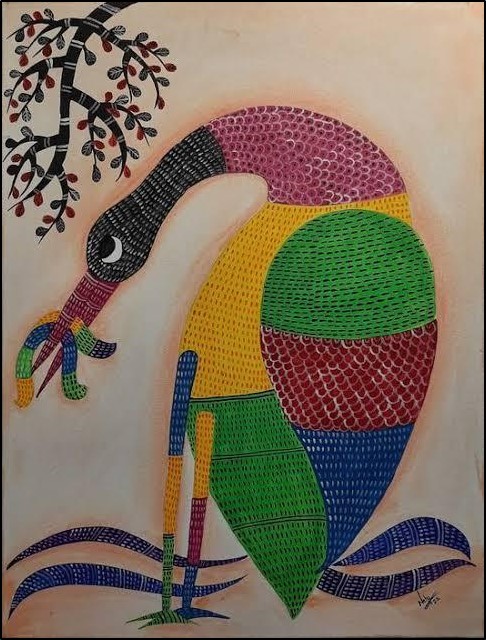
- Bell metal crafts of Bastar
The bell metal crafts of Bastar, Chhattisgarh, are an ancient art form practiced by the tribal communities, particularly the Ghadwas, for centuries, using the lost-wax casting technique (Dhokra) to create intricately designed ritual objects, figurines, and ornaments that reflect their cultural traditions and deep connection to nature and folklore.
These are items made from a mix of copper and tin. Craftspeople make things like bells, statues, and kitchen items. This craft is important to the tribal people of Bastar.
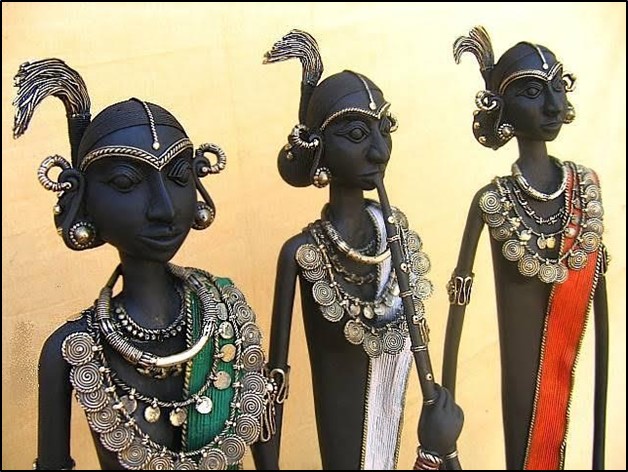
Gujarat
- Patola silk weaving of Patan
Patola silk weaving of Patan, Gujarat, is a highly sophisticated and ancient double-ikat weaving technique, in the 11th century, traditionally worn by royalty and nobility, with each intricate, handwoven design symbolizing culture and religion.
This is a special type of silk saree with designs on both sides. It takes months to make just one Patola saree. The patterns are often geometric or inspired by nature.
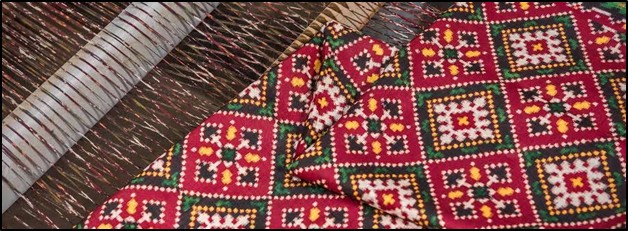
- Kutch embroidery
Kutch embroidery, a traditional art form from the Kutch region of Gujarat, India, has a famous history from centuries, characterized by vibrant colors, intricate mirror work, and diverse stitching techniques, reflecting the cultural heritage and craftsmanship of the local communities, particularly the Kutchi tribes.
This is colorful needlework from the Kutch region. It uses mirrors, beads, and colorful threads.You can find it on clothes, bags, and home decorations.
- Bandhani tie-dye textiles
Bandhani tie-dye textiles, originating from the Kutch region of Gujarat and Rajasthan, are a centuries-old craft characterized by their intricate patterns created through a resist-dyeing technique where small sections of fabric are tied tightly before dyeing, resulting in vibrant designs that reflect the cultural heritage and traditions of the region.
Tiny knots are tied in the fabric before dyeing.It creates beautiful dotted patterns on clothes and scarves.
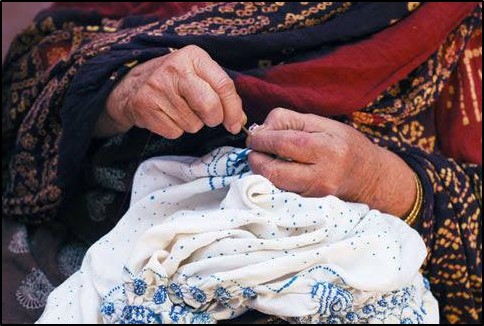
East Indian Crafts
West Bengal
- Kantha embroidery
Kantha embroidery, a traditional art form from West Bengal, is a centuries-old practice originally developed by rural women, characterized by its unique running stitches and the use of old sarees and fabric scraps to create vibrant quilts, depicting stories, folklore, and everyday life, reflecting the cultural heritage and craftsmanship of the region.
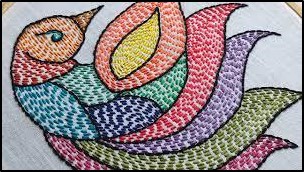
This is a type of stitching used to make quilts and scarves. It often uses old saris to create something new. The designs usually show daily life scenes or nature.
Terracotta crafts of Bankura
Terracotta crafts of Bankura, West Bengal, boast a rich historical tradition from ancient times, with artisans creating intricate sculptures, pottery, and decorative items that often depict mythological figures, rural life, and cultural motifs, reflecting the region’s artistic heritage and connection to nature.
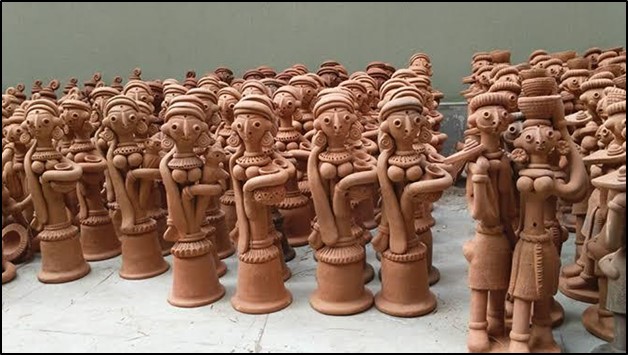
These are items made from baked clay. The most famous is the Bankura horse, a symbol of the region. Artists also make pots, toys, and decorative items.
Sholapith craft
Sholapith craft, originating from West Bengal and Odisha, is a traditional art that utilizes the pith of the shola (a type of sponge wood) to create intricate decorative items, masks, and religious artifacts, with a history of the 19th century and a cultural significance tied to festivals, rituals, and local craftsmanship.
This uses a soft, white plant material called shola. Artisans carve it into delicate designs for festivals and weddings. It’s often used to make decorations for gods and goddesses.
Odisha
- Pattachitra paintings
Pattachitra paintings of Odisha are a traditional art form with roots tracing back to the 5th century, characterized by intricate detailing, mythological themes, and the use of natural dyes on handmade cloth, often depicting stories from Hindu epics and local folklore, reflecting the rich cultural heritage and spiritual beliefs of the region.
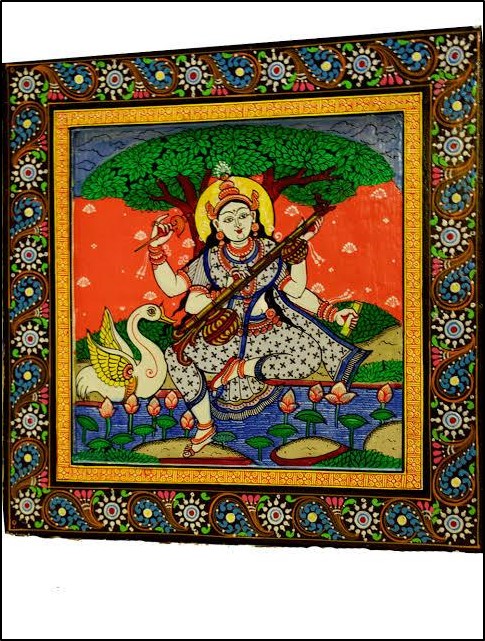
These are colorful paintings on cloth or dried palm leaves. They often show stories from Hindu myths. Artists use natural colours and fine brushes.
- Ikat weaving
Ikat weaving is an ancient textile art that dates back centuries, characterized by its unique dyeing technique where threads are dyed in intricate patterns before weaving, with a rich heritage found across various regions, particularly in India, Indonesia, and Japan, and often used to create vibrant saris, fabrics, and home textiles that reflect cultural motifs and traditions.
This is a way of dyeing threads before weaving them. It creates blurry, patterned designs on the fabric. Odisha ikat is known for its complex patterns.
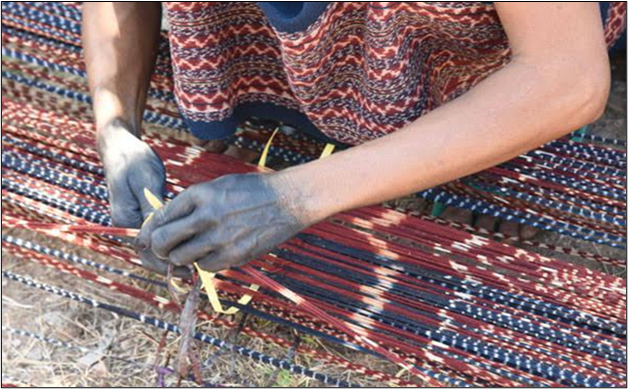
- Appliqué work of Pipli
Appliqué work of Pipli, a village in Odisha, is a traditional craft that dates back to the 10th century, known for its vibrant fabric art created by stitching colorful pieces of cloth onto a base fabric to form intricate designs and motifs, originally used for decorating temples and festivals, and now widely recognized for its cultural significance and craftsmanship.
This involves sewing colorful cloth pieces onto a base fabric. It’s used to make large, decorative umbrellas and wall hangings. The designs are usually very bright and cheerful.
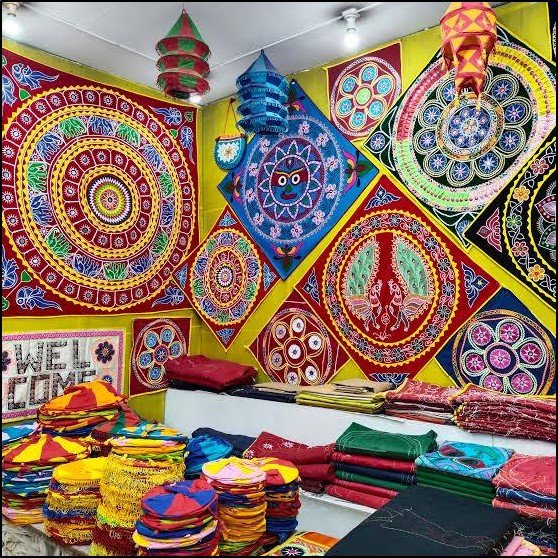
South Indian Crafts
Tamil Nadu
- Kanchipuram silk sarees
Kanchipuram silk sarees, originating from the town of Kanchipuram in Tamil Nadu, are renowned for their rich history dating back over a thousand years, celebrated for their exquisite craftsmanship, vibrant colors, and intricate gold zari work, traditionally woven by skilled artisans and often worn during special occasions and weddings, symbolizing elegance and cultural heritage.
These are heavy silk sarees with gold thread designs. They’re often worn for weddings and special occasions. Each saree can take weeks or months to make.
Tanjore paintings
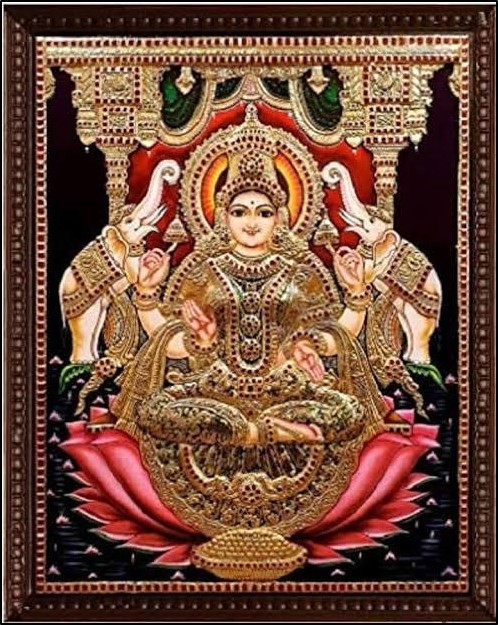
Tanjore paintings, originating from the town of Thanjavur in Tamil Nadu during the 16th century under the patronage of the Nayak and Maratha rulers, are known for their rich colors, intricate details, and the use of gold leaf, depicting Hindu gods and goddesses, and have become a significant part of South India’s cultural and religious heritage.
These are paintings of gods and goddesses on wooden boards. They use bright colours and are decorated with gold leaf and sometimes jewels. The style comes from the city of Thanjavur (Tanjore).
- Bronze casting
Bronze casting, an ancient metalworking technique From the Indus Valley Civilization in India around 2500 BCE, has been used throughout history to create statues, ritual objects, and sculptures, particularly flourishing in South India under the Chola dynasty, where it became renowned for producing intricate and lifelike representations of Hindu deities.
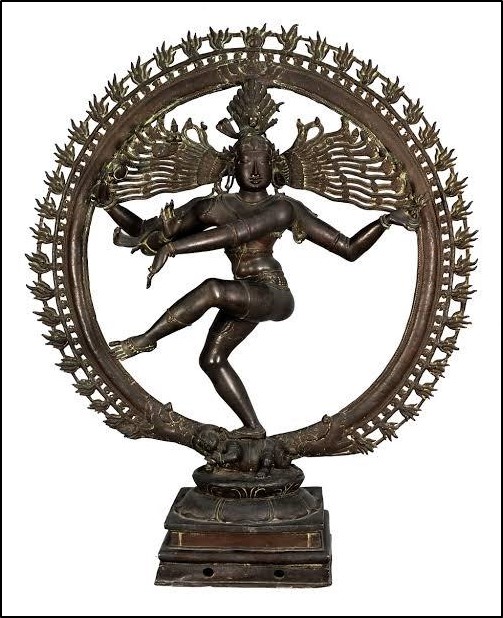
The lost-wax method is often used to create detailed designs.
Kerala
- Aranmula Kannadi (metal mirrors)
Aranmula Kannadi, a unique handcrafted metal alloy mirror from Aranmula in Kerala, has a history of over 500 years, traditionally made by skilled artisans using a secret family formula, and holds cultural and religious significance as it is associated with temple rituals and regarded as a symbol of prosperity in Kerala.
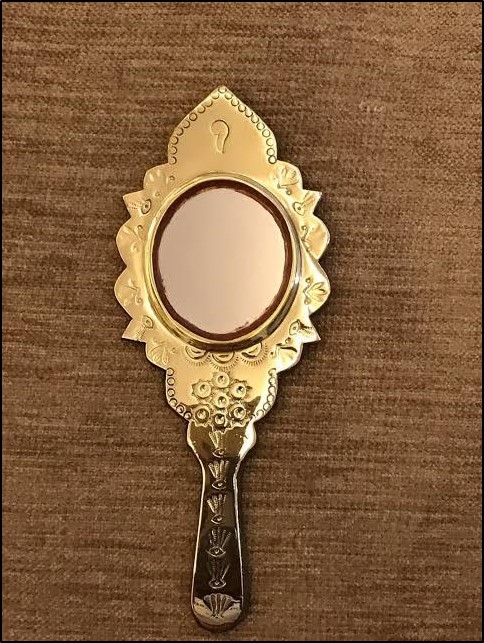
These are mirrors made from a special metal mixture, not glass. They’re handmade in the village of Aranmula. These mirrors are considered lucky and are often given as gifts.
- Coir products
Coir products, made from the fibrous husk of coconuts, have a long history in coastal regions like Kerala, From centuries this craft has been going on. traditionally used to create ropes, mats, and other household items. It’s an eco-friendly material and important for the local economy.
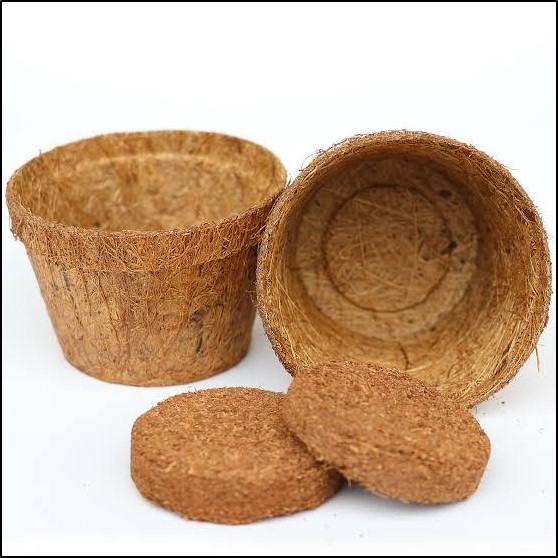
- Kathakali masks
Kathakali masks, integral to the classical dance-drama Kathakali from Kerala, have a historical tradition from centuries, originally created to enhance the visual impact of the elaborate characters from Hindu epics like the Mahabharata and Ramayana, with each mask’s vibrant colors and intricate details reflecting the distinct personality and emotions of the characters they represent.
These are colorful face makeup designs used in Kathakali dance-drama. Each colour and design represents a different character type. While not physical masks, they’re an important craft in Kerala’s culture.

Karnataka
- Mysore silk weaving
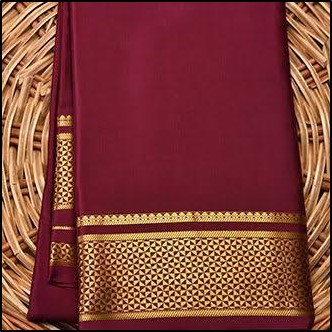
Mysore silk weaving, with a history of Tipu Sultan in the late 18th century, is Known for its luxurious silk sarees, characterized by their fine texture, vibrant colors, and rich gold zari work, and has become an iconic symbol of Karnataka’s cultural heritage and craftsmanship.
- Bidriware metal crafts
Bidriware, a traditional metal craft originating from the town of Bidar in Karnataka, From 14th century, characterized by its unique alloy of zinc and copper inlaid with silver or gold designs, This is metalwork with intricate designs often representing intricate floral and geometric patterns, and is recognized as a significant cultural heritage art form in India.
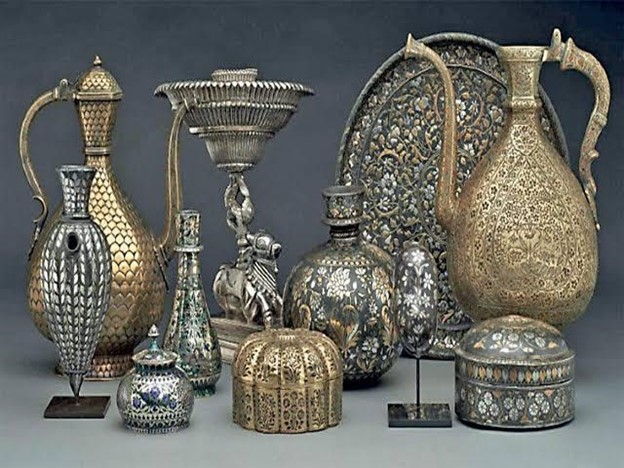
- Channapatna wooden toys
Channapatna wooden toys, crafted in the town of Channapatna in Karnataka in the 18th century. They were introduced by Tipu Sultan, and are Known for their vibrant colors and beautiful craftsmanship, made from locally sourced wood and often finished with non-toxic dyes, reflecting the region’s rich artisanal heritage.They’re made using natural dyes and are safe for children. The craft is protected by a geographical indication (GI) tag.
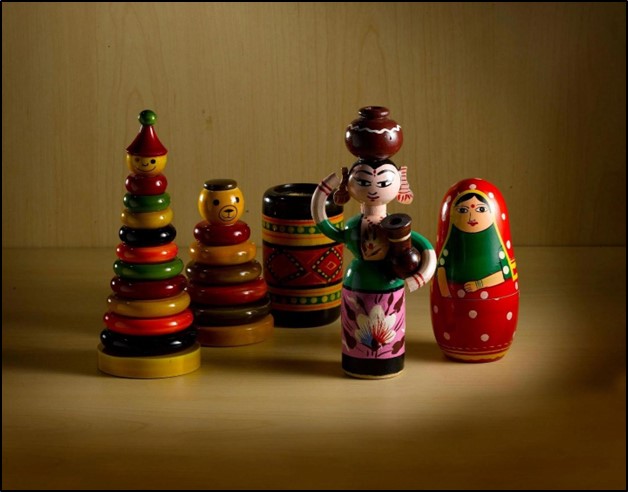
The Future of Traditional Indian Craft
Challenges faced by traditional artisans:
- Competition from machine-made goods: Cheaper, mass-produced items are often chosen over handmade crafts.
- Lack of interest from younger generations: Many young people prefer modern jobs over learning traditional crafts.
- Low income: Many artisans struggle to earn enough money from their craft alone.
- Limited access to markets: Some craftspeople in remote areas find it hard to sell their products to a wider audience.
- Shortage of raw materials: Some traditional materials are becoming harder to find or more expensive.
Government initiatives for craft preservation:
- Skill development programs: The government offers training to help artisans improve their skills and learn new techniques.
- Financial support: Loans and grants are available to help artisans buy materials and tools.
- Craft museums: These helps educate people about the importance of traditional crafts.
- Geographical Indication (GI) tags: These protect unique regional crafts from being copied.
- Craft fairs and exhibitions: The government organizes events where artisans can showcase and sell their work.
Role of e-commerce in promoting Indian crafts globally:
- Wider reach: Online platforms allow artisans to sell their products to customers around the world. (Give examples –etsy.com
- E-commerce cuts out middlemen, potentially increasing artisans’ profits.amazon.com
- Year-round sales: Unlike seasonal fairs, online shops are open all the time.
- Product storytelling: Websites can share the stories behind the crafts, helping customers appreciate their value.
- Customization options: Some online platforms allow customers to request personalized craft items.
How USA Consumers Can Support Indian Crafts
- Ethical shopping: Identifying authentic Indian crafts
When shopping for Indian crafts, it’s important to identify authentic items by looking for signs of quality. Handmade goods often have small imperfections, which can indicate authenticity. Also buying from reputable stores or websites that provide information about the artisans ensures that consumers are supporting genuine craft. Familiarizing oneself with traditional designs and patterns, asking questions about the origin and making process, and being cautious of suspiciously low prices are key steps in making informed purchases.
- Understanding the value of handmade products
Understanding the value of handmade products is essential. These items take time, for example, a single handmade Persian rug can take months or even years to complete, depending on its size and complexity. and skill to create, often requiring years of practice from artisans. Each piece is unique, as no two handmade items are exactly alike. Many of these crafts hold deep cultural significance, preserving traditional skills that have been passed down through generations. Furthermore, handmade products are often more sustainable, Utilizing natural materials and eco-friendly methods. By purchasing these items, consumers directly support the livelihoods of artisans and their communities.
- Organizations promoting fair trade in Indian crafts-
For example, The Fair-Trade Forum India (FTFI) is one of the leading organizations promoting fair trade in Indian crafts.
Several organizations are dedicated to promoting fair trade in Indian crafts. Fair Trade USA certifies products that meet social, environmental, and economic standards, while Ten Thousand Villages and Marketplace: Handwork of India sell fairly traded handicrafts and empower artisans, particularly women. The Ethical Fashion Forum offers resources on ethical fashion, including Indian crafts, and the World Fair Trade Organization connects consumers to a global network of fair-trade enterprises, many of which include Indian artisans.
Through ethical shopping, appreciating the effort behind handmade products, and supporting fair trade organizations, USA consumers can help preserve Indian cultural traditions and support skilled artisans in India.
Conclusion
India’s crafts are like a colorful patchwork quilt, each piece telling a unique story. Keeping these craft traditions alive is really important. It’s not just about having pretty things to look at or use. These crafts help people earn a living, keep old skills alive, and tell the world about India’s rich culture. When we buy and use these crafts, we’re helping to keep a piece of history alive. Remember, each handmade item has a story behind it – of the artisan who made it, the community it comes from, and the tradition it represents.
India’s crafts represent far more than beautiful objects; they are living symbols of the country’s rich cultural heritage, passed from one generation to the next. From the Complex Kashmiri shawls of the North to the vibrant Kanchipuram silks of the South, these traditions are proof to the skilled artisans who continue to preserve their communities identities. For us in the USA, representing these crafts means not only adding beauty and history to our homes but also supporting a global effort to sustain cultural diversity. By purchasing and appreciating handmade traditional Indian craft whether a Madhubani painting, blue pottery from Jaipur, or a Kalamkari textile. We contribute to the livelihoods of artisans and help preserve their invaluable skills. These crafts are more than souvenirs; they are connections to a vibrant world of creativity that uplift both India’s heritage and our global community.
